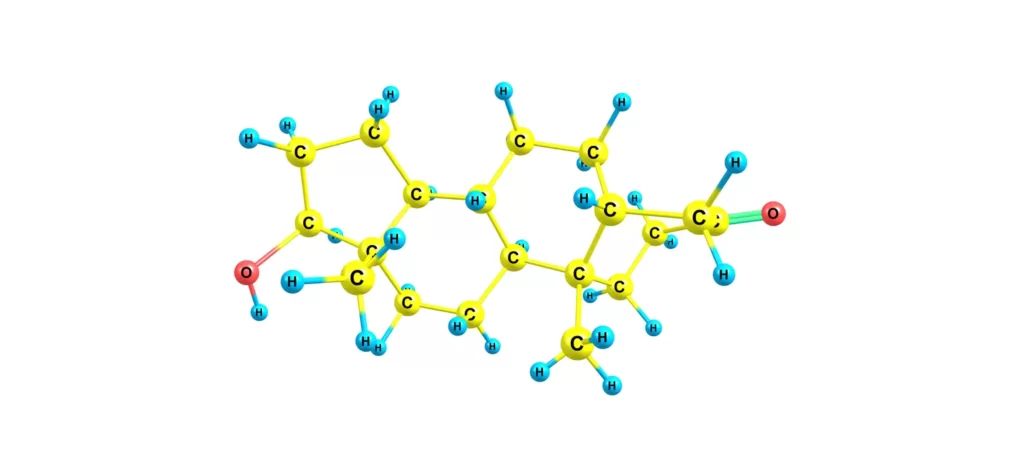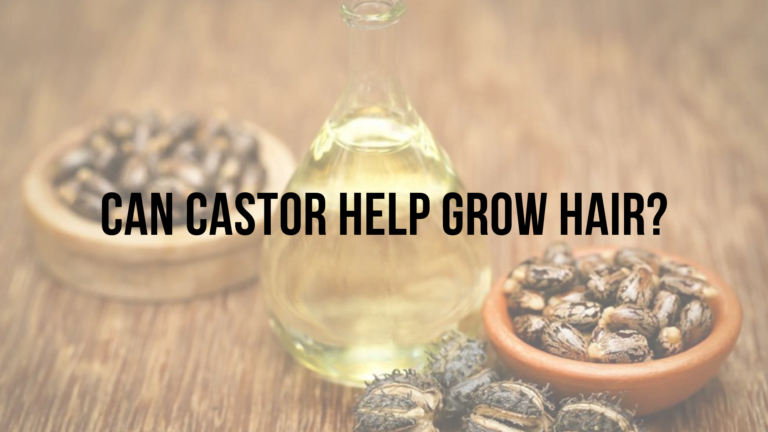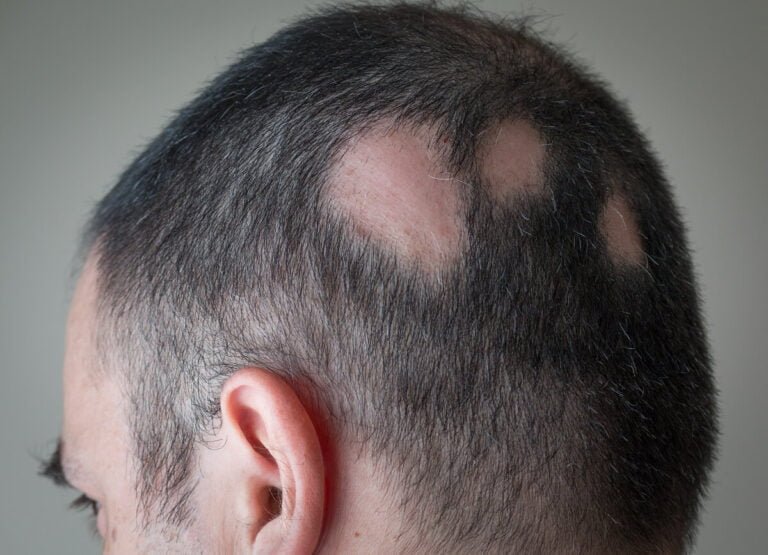One in three men over 30 and one in two over 50 have one thing in common: they suffer from alopecia, better known as hair loss. But women also have to fear for their hair. Around 20% of women suffer from hair loss.
For many alopecia patients, hair loss is a family affair. In other words, it is genetic in origin. In this case, dihydrotestosterone wreaks havoc on the body. But what exactly is it, what does it do, and how can we stop it?
We asked the Medical Director Dr. Hans-Georg Dauer to answer to help us on the medical facts of this article.
What is dihydrotestosterone (DHT)?
Dihydrotestosterone, or DHT, is a transformation of the sex hormone testosterone (metabolite), which belongs to the androgen group of hormones.
The enzyme 5-alpha-reductase is responsible for this transformation. It triggers a chemical reaction that transforms testosterone into DHT. But that’s not a bad thing in itself.
On the contrary: in fact, DHT is a good thing. It plays a central role in the development of the male embryo. It’s just as active during puberty.
Without testosterone, a boy cannot become a man. It plays a decisive role in beard growth and male body hair in general. DHT is also active in sebaceous gland function and prostate development.
DHT is not only found in men. This breakdown product of testosterone is also present in small quantities in the female body.
Good to know: we often confuse DHT with DHEA (dehydroepiandrosterone). Yet their similar sounding names don’t mean the two are identical. On the contrary: compared to DHT, the steroidal homrone DHEA has a significantly lower effect in the body.

How is DHT produced?
DHT is produced from testosterone in so-called target organs – for example, in the prostate, epididymides or seminal vesicle. But the doctor prefers to speak of a reduction in the male sex hormone, testosterone, by the enzyme 5α-reductase.
Hard to imagine, but DHT rarely travels alone in the body. Most of the breakdown product, no less than 99 percent, is bound to globulins (Shbg), proteins that make our sex hormones. Only 1% of DHT moves freely in the bloodstream.
And it’s precisely this unbound DHT that can readily bind to androgen receptors in target organs such as the prostate or seminal vesicle – just like testosterone. When androgen receptors are in resting mode, they are bound to so-called heat shock proteins which actively ensure receptor stability in the cell cytoplasm.
When DHT comes into contact with androgen receptors, it triggers a conformational change. In other words, the heat shock protein and the hormone-receptor complex are released into the cell nucleus.
In the cell nucleus, this complex can now bind freely to DNA elements known as “androgen-responsive elements”.
Would you have imagined it? DHT and testosterone act identically. However, DHT is even more powerful than testosterone. This is because it has a higher affinity for the androgen receptor, which significantly increases its effectiveness.
How does DHT work in the male and female body?
In men, DHT is truly versatile. Not only is it involved in the development of the male embryo, it also controls body and facial hair. DHT creates a masculine look, so to speak. At the same time, this versatile substance regulates sebum production in our skin and shapes the male sexual organs, specifically the prostate.
But that’s not all: would you have thought that DHT is also responsible for the moulting of the voice? It’s what gives men their deep, distinctive voice. Good news for sports enthusiasts: DHT is also essential for the development of muscle mass.
Does DHT play no role in women? Wrong, dihydrotestosterone is also an important player in the female body. In fact, DHT is the precursor for the synthesis of female sex hormones. Conversely, this means that testosterone is not only the precursor of DHT, but also of the female sex hormone estradiol.
Androgens also perform independent functions in the female body. They strengthen muscles, stimulate the sexual pleasure center and reinforce bones. What’s more, they help shape a woman’s physical and psychological sexual role.
But what happens when DHT levels aren’t balanced? And if it’s too high?
It’s not that rare. In congenital adrenal hyperplasia, DHT levels rapidly become unbalanced. The same applies to tumors of the adrenal glands or ovaries, as well as testicular tumors.
PCO syndrome, a polycystic ovary syndrome, is also a possibility. This is an excess of testosterone in a woman’s body.
But what are the consequences of high levels of DHT in the blood?
In men, too high a level of DHT, more specifically 5α-dihydrotestosterone, often causes puberty to start too early. Women, on the other hand, experience masculinization (virilization). In other words, their physical appearance suddenly seems more androgynous.
It’s not uncommon for women with high DHT levels to suffer from hirsutism. By this we mean heavy body and facial hair that resembles the male growth pattern. This is particularly true of the intestinal beard, chest or back.
This phenomenon is particularly common among top-level sportswomen who wish to stimulate their muscular development with the help of doping products. The reason: the increased proportion of male sex hormones in the female body upsets the hormonal balance. Female hormones decrease and male hormones increase. As a result, a woman’s appearance becomes all the more masculine.
A rarer phenomenon is called adrenogenital syndrome. This is an inherited disorder in which the synthesis of female hormones is disrupted. As a result, external male genitalia are formed, which doctors call female pseudohermaphroditism.
DHT levels in the blood can be not only too high, but also too low. In this case, libido is generally disturbed or the sexual organs are not properly formed. In the worst case, there’s even a risk of impotence.
The two most common known disorders associated with low DHT (androstanolone) levels are male pseudohermaphroditism and Klinefelter’s syndrome.
How can I lower my DHT levels?
You can breathe easy: you can indeed do something about your high DHT levels. How about 5α-reductase inhibitors, for example? Here, the name says it all: the drugs reliably stop 5-alpha-reductase. This means that less testosterone is converted into DHT. And the less DHT in the body, the better.
Among the most popular 5α-reductase inhibitors are finasteride, dutasteride or alfatradiol. All three inhibit testosterone production by paralyzing 5-alpha-reductase. And the less testosterone circulates in the body, the less DHT is produced – mission accomplished.
But it’s not only drugs that can significantly reduce DHT levels in the bloodstream. Secret herbal tricks are also worth a try, namely
- Sulforaphane (mustard oil glycosides): Note to vegetable lovers: isothiocyanates of the sulforaphane family are found in broccoli and all varieties of cabbage. Even kohlrabi, horseradish, rocket, watercress, radish, black radish and mustard contain this miraculous green substance.
- Theaflavin (black tea extract): Now you can turn to black tea with a clear conscience. What better supplier of theaflavin?
- Fenugreek seeds: Trust the active ingredients trigonelline and diosgenin in fenugreek seeds. They are said to inhibit the production of DHT. By the way, we especially appreciate fenugreek seeds as a spice.
- Flaxseeds: The peripheral layers of flaxseeds are like treasure chests, packed with lignans. And it’s precisely these secondary plant substances of the phytoestrogen family that are worth their weight in gold. The reason: they inhibit DHT.
Hereditary hair loss – What can I do?
We can’t change our genetics. But we don’t have to accept it without saying anything. Fortunately, there are a number of treatments available today that can effectively combat baldness on the head.
At least, that’s what the statistics say. Curious? Then let’s take a look at the most promising methods for combating hereditary hair loss.
Minoxidil: a classic
Many patients suffering from alopecia treat their condition with minoxidil – whether with tinctures or shampoos.
Indeed, regular use of this highly coveted active ingredient has been proven to halt the progression of hair loss and even regrow vigorous new hair.
The exact mechanism of action of minoxidil in the human body has yet to be clearly elucidated. However, experts do have a hypothesis: minoxidil must stimulate blood circulation in the scalp.
And the more efficient the blood circulation, the more nutrients and oxygen the hair roots receive. Their chances of survival are all the greater.
But beware: minoxidil is only a temporary solution to hereditary hair loss. As soon as you stop taking it, everything goes back to square one.
Finasteride
Finasteride also enjoys great popularity in the treatment of alopecia. And for good reason: this active substance blocks the enzyme responsible for DHT production, namely 5-alpha-reductase.
The effect is gratifying: there’s considerably less DHT in circulation. And the less DHT in circulation, the lower the probability of hereditary hair loss.
Good to know: As with minoxidil, the effect of finasteride wears off as soon as we stop taking the preparations. So, once again, it’s a temporary solution.
Hair transplant
Tired of minoxidil and finasteride? Because you’re not looking for a temporary solution, but a lasting one? Are you declaring war on your hereditary alopecia once and for all?
Then we have the solution for you. Why not opt for a professional hair transplant at Hair & Skin? The big advantage: the transplanted hair roots will stay with you for the rest of your life. They won’t fall out again. Sounds attractive? But how exactly should I imagine the procedure?
First of all, our experienced doctor removes solid donor hair from a densely vegetated area. Most of the time, he concentrates on the back of the head. DHT is less effective there. He then prepares the recipient area for the grafts. To do this, he opens tiny channels in the scalp, creating space for a living head of hair.
In the next step, he inserts the hair roots step by step into the fine channels. In doing so, the doctor is careful to respect the patient’s natural direction of growth. In the end, the result should look as harmonious and regular as possible.
Once this is done, all that remains is a little patience. It takes between 9 and 12 months before we can finally see the final result. But after that, we’ll be able to enjoy a vigorous, dense, young and fresh coat for the rest of our lives.
DHT – what does it really do?
We regularly read negative headlines about DHT. But is everything about testosterone production inherently bad? No, not at all. DHT also has its good points.
We can’t do without DHT when we make the transition from boy to man. After all, it plays an active role in beard growth and the formation of male sexual organs such as the prostate. Of course, it also plays a part in the functioning of the sebaceous glands.
The situation only becomes worrying when the DHT level in our blood becomes unbalanced, particularly when it becomes too high. Experts are convinced that high levels of DHT increase the risk of prostate cancer or prostatic hyperplasia (a benign enlargement of the prostate gland).
DHT and hair loss: what’s the link?
At first glance, DHT and hair loss don’t seem to have much in common. But a closer look reveals that they’re more closely linked than you might have thought. Because did you know that DHT is a typical cause of hair loss?
In fact, DHT is even considered one of the most common triggers of this cosmetic imperfection. It’s not without reason that it’s nicknamed “the hair loss hormone”.
Whenever androgenetic alopecia or hereditary hair loss is present, DHT is involved. In this case, hair roots are hypersensitive to DHT. They simply can’t deal with it. In addition to hypersensitivity of the hair roots, too high a concentration of DHT in the body is often the cause of hereditary hair loss.
Normally, DHT causes no problems in the body. It simply sits in the scalp, where it binds to special receptors in the hair roots.
If testosterone levels are balanced, and hair roots are not hypersensitive to DHT, this process goes smoothly. DHT stimulates protein production, giving hair cells a strong growth spurt.
The reaction: the overworked hair root forms essential blood vessels, so that it can no longer be supplied with sufficient nutrients and oxygen. The result is a lack of supply which, over time, shortens the hair’s growth phase (anagen phase).
As a result of the greatly shortened growth phase, our hair remains in an intermediate state for an extraordinarily long time, in which it is particularly fine and barely recognizable on the scalp. The hair root then atrophies. It regresses little by little, until it falls out.
Did you know? DHT does not necessarily affect body hair. For example, patients with androgenetic alopecia may have abundant hair on their chest or back, but still have bald spots on their head.
Does blocking DHT have side effects?
Blocking dihydrotestosterone (DHT), a potent form of testosterone, is a common approach in treating conditions like androgenetic alopecia (male pattern baldness) by using Finasteride for example.
However, inhibiting DHT can lead to various side effects due to its role in the body’s hormonal balance. Some potential side effects of blocking DHT include:
- Sexual side effects: DHT plays a crucial role in sexual function. Blocking DHT can lead to decreased libido, erectile dysfunction, and potential complications with ejaculation.
- Mood changes: DHT is linked with mood regulation. Inhibiting its production can lead to mood swings, depression, or anxiety in some individuals.
- Gynecomastia: DHT contributes to the balance between testosterone and estrogen in the body. Lower DHT levels may result in an imbalance, potentially leading to the development of breast tissue in men.
- Fatigue and lethargy: Some individuals may experience fatigue, lack of energy, or decreased physical stamina as a result of altered hormonal balance due to DHT inhibition.
- Muscle loss and weight gain: DHT is involved in maintaining muscle mass and regulating body fat distribution. Inhibiting DHT could lead to muscle loss and an increase in body fat.
- Hair changes: Paradoxically, while DHT is linked to male pattern baldness, blocking DHT can also affect hair growth on other parts of the body, leading to changes in body hair.
- Prostate complications: While DHT contributes to prostate enlargement, blocking it could lead to a reduction in the size of the prostate. However, it could also lead to potential complications and might mask symptoms of prostate issues or prostate cancer.
- Potential bone health implications: DHT plays a role in maintaining bone density. Inhibiting DHT could potentially impact bone health, leading to conditions such as osteoporosis.
It’s important to note that these side effects can vary significantly from person to person and also depend on the specific methods or medications used to block DHT.
Consulting with a healthcare professional before starting any treatment that alters hormone levels is crucial to understand the potential risks and benefits, as well as how to manage or mitigate side effects.






